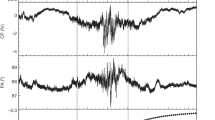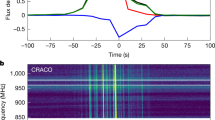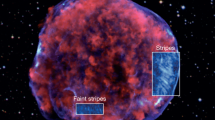Abstract
GX17 + 2 (4U 1813 – 14) is a bright X-ray binary1,2 in which matter is accreting on to a neutron star from a nearby companion. X-ray bursts, which are due to thermonuclear flashes on the surface of the neutron star3, are sometimes observed4–6, as well as quasiperiodic oscillations in the X-ray flux. The frequencies of the quasiperiodic oscillations depend on the spectral state of the source7–13, which manifests itself as three distinct spectral 'branches' in an X-ray colour–colour diagram. GX17 + 2 is also a variable radio source14–20; there is no believable optical counterpart21–23. We report here on simultaneous X-ray and radio observations which showed a connection between the spectral branches and the radio brightness. The 6-cm and 20-cm flux density increased by factors of 30 ± 5 and 40 ± 10, respectively, as the X-ray state changed from the so-called 'flaring branch' to the 'horizontal branch'. We suspect that this X-ray/radio connection is common among bright low-mass X-ray binaries.
This is a preview of subscription content, access via your institution
Access options
Subscribe to this journal
Receive 51 print issues and online access
$199.00 per year
only $3.90 per issue
Buy this article
- Purchase on SpringerLink
- Instant access to full article PDF
Prices may be subject to local taxes which are calculated during checkout
Similar content being viewed by others
References
Forman, W., Jones, C. & Tananbaum, H. Astrophys. J. 208, 849–862 (1976).
Ponman, T. Mon. Not. R. astr. Soc. 201, 769–799 (1982).
Lewin, W. H. G. & Joss, P. C. in Accretion Driven Stellar X-Ray Sources (eds Lewin, W. H. G. and van den Heuvel, E. P. J.) 41–115 (Cambridge University Press, 1983).
Kahn, S. M. & Grindlay, J. E. Astrophys. J. 281, 826–829 (1984).
Tawara, Y., Hirano, T., Kii, T., Matsuoka, M. & Murakami, T. Publs astr. Soc. Japan 36, 861–867 (1984).
Sztajno, M. et al. Mon. Not. R. astr. Soc. 222, 499–511 (1986).
Stella, L., Parmar, A. N. & White, N. E. Astrophys. J. 321, 418–424 (1987).
Hasinger, G. Astr. Astrophys. 186, 153–158 (1987).
Hasinger, G. Proc. ‘Oda’ Conf. (Tokyo, 1988).
Penninx, W. et al. Mon. Not. R. astr. Soc. (submitted).
Langmeier, A., Hasinger, G., Sztajno, M., Trümper, J. & Pietsch, W. IAU Circ. 4147 (1985).
Langmeier, A. thesis, Munich Univ. (1988).
Lewin, W. H. G., van Paradijs, J. & van der Klis, M. Sp. Sci. Rev. 46, 273–378 (1988).
Hjellming, R. M. & Wade, C. M. Astrophys. J. 168, L21–24 (1971).
Braes, L. L. E. & Miley, G. K. IAU Symp. 55, 86–97 (1973).
Hjellming, R. M. Astrophys. J. 221, 225–227 (1978).
Geldzahler, B. J. Astrophys. J. 264, L49–53 (1983).
Hjellming, R. M. & Johnston, K. J. in Radio Stars (eds Hjellming, R. M. & Gibson, D. M.) 309–323 (Reidel, Dordrecht, 1985).
Hjellming, R. M. & Johnston, K. J. in The Physics of Accretion onto Compact Objects (eds Mason, K. O. & White, N. E.) 287–301 (Springer, Berlin, 1986).
Grindlay, J. E. & Seaquist, E. R. Astrophys. J. 310, 172–175 (1986).
Tarenghi, M. & Reina, C. Nature 240, 53–54 (1972).
Davidson, A., Malina, A. & Bowyer, S. Astrophys. J. 203, 448–454 (1976).
Lewin, W. H. G. & van Paradijs, J. Astr. Astrophys. 142, 361–362 (1985).
Makino, F. and the Ginga team Astrophys. Lett. Commun. 25, 223–233 (1987).
Turner, M. J. L. et al. Publs. astr. Soc. Japan (submitted).
Garcia, M. R. et al. Astrophys. J. 328, 552–558 (1988).
Kellermann, K. I. in Galactic and Extra-Galactic Radio Astronomy (eds Verschuur, G. L. & Kellermann, K. I.) 320–352 (Springer, Berlin, 1974).
Hjellming, R. M. in Galactic and Extra-Galactic Radio Astronomy (eds Verschuur, G. L. & Kellermann, K. I.) 115–133 (Springer, Berlin, 1988).
Molnar, L. A., Reid, M. J. & Grindlay, J. E. Nature 310, 662–665 (1984).
Haynes, R. F., Lerche, I. & Murdin, P. Astr. Astrophys. 87, 299–302 (1980).
Taylor, A. R. & Gregory, P. C. Astrophys. J. 283, 273–278 (1984).
Seaquist, E. R., Gilmore, W. S., Johnston, K. J. & Grindlay, J. E. Astrophys. J. 260, 220–232 (1982).
Hjellming, R. M., Calovini, T. A. & Cordova, F. A. IAU Circ. 4607 (1988).
Schulz, N. S., Hasinger, G. & Trümper, J. Astr. Astrophys. (submitted).
Lewin, W. H. G. et al. Mon. Not. R. astr. Soc. 226, 383–394 (1987).
Van Paradijs, J. et al. Mon. Not. R. astr. Soc. 231, 379–387 (1988).
Hasinger, G., Priedhorsky, W. & Middleditch, J. Astrophys. J. (in the press).
Kaluzienski, L. J., Holt, S. S. & Swank, J. H. Astrophys. J. 241, 779–786 (1980).
Makino, F. IAU Circ. 4587 (1988).
Lampton, M., Bowyer, S., Welch, J. & Grasdalen, G. Astrophys. J. 164, L61–65 (1971).
Bradt, H. V. et al. Astrophys. J. 197, 443–455 (1975).
Canizares, C. R. et al. Astrophys. J. 197, 457–466 (1975).
Miyamoto, S. & Matsuoka, M. Sp. Sci. Rev. 20, 687–755 (1977).
Author information
Authors and Affiliations
Rights and permissions
About this article
Cite this article
Penninx, W., Lewin, W., Zijlstra, A. et al. A connection between the X-ray spectral branches and the radio brightness in GX17 + 2. Nature 336, 146–148 (1988). https://doi.org/10.1038/336146a0
Received:
Accepted:
Issue date:
DOI: https://doi.org/10.1038/336146a0
This article is cited by
-
Understanding the inner structure of accretion disk in GX 17+2: AstroSat’s outlook
Journal of Astrophysics and Astronomy (2021)
-
AstroSat/LAXPC view of GX 17+2: spectral evolution along the Z-track
Astrophysics and Space Science (2020)
-
Accretion Disks and Coronae in the X-Ray Flashlight
Space Science Reviews (2018)
-
Hard X-ray Emission along the Z Track in GX 17 + 2
Journal of Astrophysics and Astronomy (2015)
-
What can we learn from Neutron Star X-Ray Binaries' JETS?
Astrophysics and Space Science (2005)



